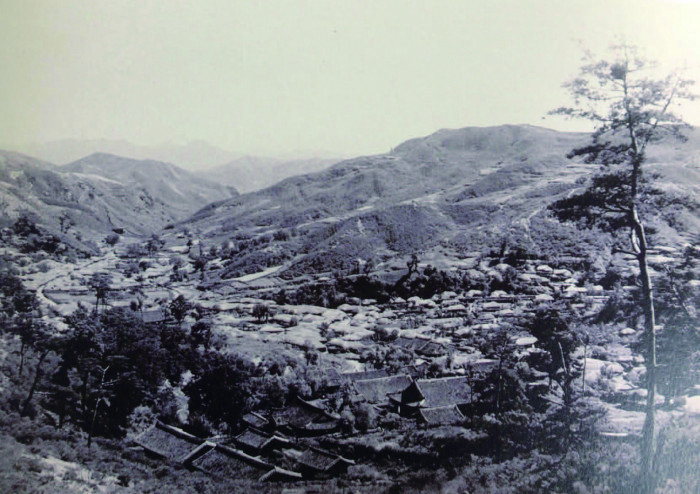경기문화재단
Sanseong-ri and Geumrim Cooperative
Protector of Namhansanseong
"Stories on the Road" is a story about a UNESCO World Heritage site and a story. It will tell you the life and spirit of our ancestors in the ancient road of The old Namhansanseong path.
|
City

View of Namhansanseong Sanseong-ri / 1909-1927
“Sanseong-ri, the second largest consumer city after Hanyang”
During the Joseon Dynasty, Hanyang was a city of over 200,000 residents. The scale of Hanyang’s population at the time can easily be pictured in comparison to London’s population of 50,000 during the Industrial Revolution of the late 18th century. The Sanseong-ri area where the old Namhansanseong path is located was a consumer city adjacent to Hanyang, and, according to local reports, there is an anecdote saying that residents within the fortress would look down on the villagers living in surrounding towns as peasants. In 1627 (the 5th year of King Injo’s reign), the population of Sanseong-ri began to skyrocket as the administrative center of Gwangjubu relocated to the inner part of the fortress. However, Gwangju Yusubu was abolished according to the reorganization of administrative districts after Gabo Reform of 1895, and, in 1914, merger of administrative districts by the government-general in Joseon also stripped the area’s functions as a center, leading to its gradual decline. As the Gwangju-gun Office, which had been situated within the fortress, was moved to Gyeongan-dong by the Japanese government, its dignity as a military and administrative city disappeared completely, and, since the beginning of the era of modernization, main roads were built without any consideration for Namhansanseong Fortress. Namhansanseong Fortress, once one of the most prosperous areas south of the Hangang River, has slowly but surely turned into a secluded village and momentarily disappeared into the backdrop of history.
Population
“The people who protect the once glorious Sanseong village”
Namhansanseong Fortress features excellent conditions suitable for a defense facility. The area of Namhansanseong Fortress is surrounded by high mountains, making the fortress difficult to attack from the outside, while at the same time the inner part of the mountain is formed as basin terrain, allowing stationing of military troops as well as residence for common people. At the time, Joseon recruited a population of residents to live in Namhansanseong Fortress, the number of households recruited being around 300. The residents were promised exemption from forced labor and taxes. Many residents who wanted to evade forced labor and taxes gathered at the fortress, and the number of households within Namhansanseong Fortress reached 1,000, leading to the abolition of the recruitment policy in 1691 (the 17th year of King Sukjong’s reign). Since then, the population was maintained in a stable manner with around 4,000 residents in 1,000 households until the end of the 19th century. However, after Gwangju Yusubu was abolished, and subsequently its status as the center of area was lost, the residents of the fortress who had been crowded there for 300 years began to leave the village. Around 200 residents who did not leave the village even in the aftermath of the Korean War maintained their livelihood through commercial activity, and their descendants still guard and reside in the fortress town today.
Geumrim Cooperative, protecting the trees

Yeongse Bulmangbi in commemoration of Seok Dong-gyun (right) and Kim Yeong-rae (left), former leaders of the Geumrim Cooperative
The forests of Namhansanseong are a beautiful ecological heritage that has been very well preserved. This reflects the will of the fortress residents who had long been trying to protect the forests within Namhansanseong. In general, most of the mountains often became barren in the early 20th century because the primarily form of fuel for living was wood before the modernization era. The forests within the fortress, however, were an exception, as the trees have survived in today’s healthy state thanks to the "Geumrim Cooperative" and a forest patrol center, Sunsanwon, set up by the villages to prevent timber theft. The Geumrim Cooperative selected 50 Sangams, or forest guards, and directing 6 of them to take turns each day for surveillance and protection of the forests. Since Sangams were selected from the most impoverished classes of the society, the system helped not only protect forests but also to support the disadvantaged class. The efforts of the Geumrim Cooperative have continued for nearly 90 years until 2016, which has allowed Namhansanseong Fortress to faithfully preserve these valuable ecological cultural resources and pass them on to future generations.
<ggc의 모든 콘텐츠는 저작권법의 보호를 받습니다.>
세부정보
Stories on the Road
Published by/ Namhansanseong World Heritage Centre, Gyeonggi-do The Center for Gyeonggi Studies, Gyeonggi Cultural Foundation
Published on/ November 24, 2017
Supervised by/ Lee Ji-hoon, Director of the Center for Gyeonggi Studies, Gyeonggi Cultural Foundation
Planned and coordinated by/ Chae Chi-yong, Senior Researcher at the Center for Gyeonggi Studies, Gyeonggi Cultural Foundation Park Da-seul, Researcher at the Center for Gyeonggi Studies, Gyeonggi Cultural Foundation